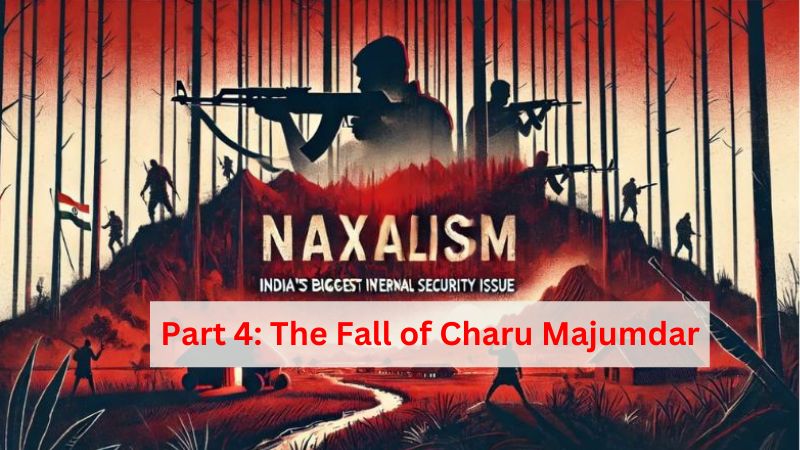With the fall of its leader, any movement dwindles to unprecedented scale and the Naxal movement was no exception to that. In the last part of our series on Naxalism, we explored the rise of Naxalism which led the government to initiate Operation Steeplechase. As a result, the political ideologue of the movement, Charu Majumdar was arrested and he died afterwards. This part highlights how the consolidated and aggressive CPI (ML) disintegrated into a number of factions after Charu Majumdar but it still intensified terrorising people with greater intensity.
For the whole decade of 1970s, the Naxalism movement kept intertwined in internal rifts and fragmentation. At least 40 separate factions were formed during the period. The biggest splinter of CPI (ML) was Central Organising Committee, Communist Party of India (Marxist–Leninist) COC, CPI (ML) formed in 1972. The fragmentation led to reduction in naxal crimes. It could be termed as the brief period of success of the Operation Steeplechase. The 1975 emergency further broke the nerve of the Naxalism before it startes to rise in Andhra Pradesh in 1980s.
Also Read: TFI Series on Naxalism Part 1 continued: Status report on Most wanted Naxals
By 1978, CPI(ML) realised a need for it to revamp its approach and hence a Rectification Movement was launched to rein in militantcy outlook and strive for more peasantry-oriented mass struggle. In 1977, Kondapalli Seetharamaiah, one of the most influential Maoist, broke away from COC, CPI (ML) and in 1980, he formed CPI-ML (People War) commonly known aa the Peoples War Group (PWG) in Andhra Pradesh. The event marked the fresh start of escalation in naxal violence which were even more aggressive.
The movement was even more signifucant because Seetharamaiah had formed the PWG by aliging with Tamil Nadu-based Maoists, further extending grounds.Seetharaman made unpaid wages a core issue and his group actively startd kidnapped landlords and forced them to confess to crimes, apologize to villagers, and repay forced bribes.
The movement was again leading to mounting concerns for the state and Centre. The weakened fragments startes becoming atrong and act as per their capabilities leading to a sort of multi-front challenge. While PWG was gaining control of areas rampantly and continued their violence against upper-caste and landlords other factions including CPI-ML were busy with other efforts, including reunion bids and wooing Sikh separatists in the wake of Operation Bluestar. In 1985, the groups turned further hostile as they started ambush attacks on police. The Andhra Pradesh government banned PWG in 1987. After an Sub-Inspector was killed by Maoists in Andhra and the attacks of security forces startes to raise concerns, the state came up with a dedicated task force of specially trained elite police officials known as Greyhounds in 1989. It was raises by IPS officer KS Vyas.
The task force proved effective in unprecedented way, so much so, that it continues to haunt the Naxalites even today. Its success inspired other states to form the dedicated task forces like Odisha’s Special Operations Group, Maharashtra’s C-60, West Bengal’s Counter Insurgency Force and Chhattisgarh’s CoBRA battalion of the Central Reserve Police Force. As said that other fractions were also involved actively in carrying out their struggle in their own way, in 1989, Ara in Bihar became the first to send a Naxalits to Parliament. However, on the eve of polls more than a dozen “left supporters” are shot dead by landlords. Earlier in 1986, over dozens landless labourers were killed in police firing in Bihar’s Jehanabad.
So at one place, the guerilla warfare was underway and the forces were struggling to curn their menace, the killings of labouruers and other left affiliated individuals was sending chills in Bihar. These two separate scenarios are sufficient to tell the exact reason why ultra-left Maoists were successful in deceiving and exploiting the masses while maintaining their relevance. In 1991, PWG ban was lifted for a brief period of time but was reimposed in 1992. In December 1991, the naxal attacks intensified and Andhra implemented strict laws granting power to security forces.
Besides, the government also brough rehabilitation policy for the first time and establish new informant network. Evidently, the approach turned successful as incidents of violence significantly reduced and over 9,000 Naxalites surrenderd, marking the first ever arm-laying at such a scale. Broadly speaking, till 1975, India faced the first wave of Naxal insurgency which ended with Steeplechase and political upheaval in thinsurgency. After this, the new rise, which is discussed in this article, marked the second phase of insurgency.
Also Read other stories of this Series —
TFI Series on Naxalism Part 3: Operation Steeplechase, the first major crackdown on Naxalites
The fragmentation of CPI-ML, formation of PWG, shift in Maoist strategy by attacking forces were the prominent development of this phase which ended in 1945. The surrender and reduction in Maoist violence in early 1990s again raised hope for the end of Naxalism. Howevet, contrary to the anticipation the Naxalite movement intenfied with each phase. In third phase, it further aggravated the situation and took the form of biggest internal security threat in the 21st Century.
